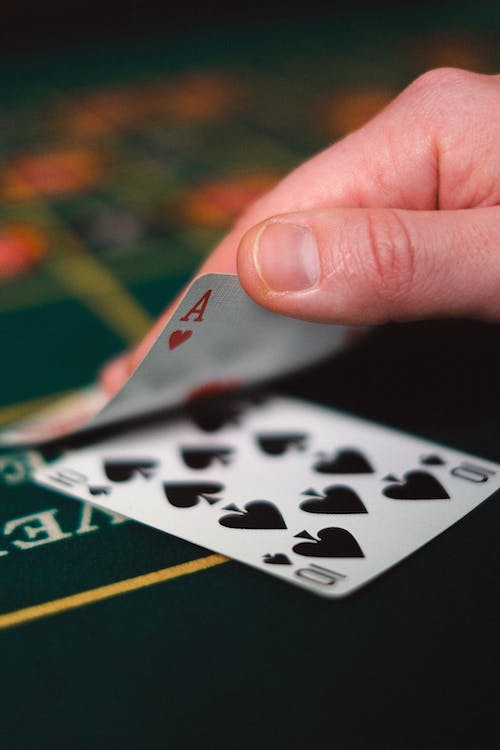
Poker is a game of skill and strategy that requires players to constantly improve their game in order to succeed. Advanced players have already mastered the basics of the game and are looking for ways to take their skills to the next level. In this article, we will provide some tips and strategies for advanced poker players to help them improve their game and increase their chances of winning.
Mastering the Art of Bluffing in Poker: Tips for Advanced Players

Poker is a game of skill, strategy, and luck. It is a game that requires players to make quick decisions based on incomplete information. One of the most important skills in poker is the ability to bluff. Bluffing is the art of making your opponents believe that you have a better hand than you actually do. It is a powerful tool that can help you win pots that you would otherwise lose. Here, we will discuss some tips for advanced players who want to master the art of bluffing in poker.
The first tip for bluffing in poker is to choose your spots carefully. Bluffing is not something that you should do all the time. It is a tool that should be used sparingly and strategically. You should only bluff when you have a good reason to do so. For example, if you are in a late position and everyone else has folded, you may want to try to steal the blinds by making a small bet. However, if you are in an early position and there are still several players left to act, bluffing is probably not a good idea.
The second tip for bluffing in poker is to pay attention to your opponents. You should try to get a read on your opponents and figure out how they play. Some players are more likely to call a bluff than others. If you are playing against a player who is very tight and conservative, you may want to avoid bluffing altogether. On the other hand, if you are playing against a player who is very loose and aggressive, you may be able to bluff more often.
The third tip for bluffing in poker is to use your position to your advantage. Your position at the table can have a big impact on your ability to bluff. If you are in a late position, you have more information about what your opponents are doing. You can use this information to make better decisions about when to bluff. For example, if you are in a late position and everyone else has checked, you may want to make a small bet to try to steal the pot.
The fourth tip for bluffing in poker is to be consistent. If you are going to bluff, you need to be consistent in your actions. You should always make the same bet size when you are bluffing. This will help to make your bluffs more believable. If you make a small bet when you are bluffing one time and a large bet the next time, your opponents will be able to pick up on this and adjust their play accordingly.
The fifth and final tip for bluffing in poker is to be confident. Bluffing requires a certain level of confidence. You need to be able to make a bet or raise without hesitation. If you hesitate or show any signs of weakness, your opponents will be able to pick up on this and call your bluff. You should also be prepared to follow through with your bluff if you are called. This means that you should have a plan for what you will do if your bluff is called.
Bluffing is an important skill in poker. It is a tool that can help you win pots that you would otherwise lose. However, it is a tool that should be used sparingly and strategically. You should only bluff when you have a good reason to do so. You should also pay attention to your opponents, use your position to your advantage, be consistent, and be confident. By following these tips, you can become a master of the art of bluffing in poker.
Advanced Strategies for Reading Your Opponents in Poker
The first thing to keep in mind is that every player has a unique playing style. Some players are aggressive, while others are passive. Some players are tight, while others are loose. Understanding your opponent’s playing style is essential in determining their hand strength. For example, if a player is tight and only plays premium hands, you can assume that they have a strong hand when they raise or re-raise.
Another important aspect of reading your opponents is observing their body language. Body language can reveal a lot about a player’s hand strength. For example, if a player is nervous and fidgety, they may be bluffing. On the other hand, if a player is calm and relaxed, they may have a strong hand. Pay attention to your opponent’s facial expressions, posture, and hand movements.
One of the most effective ways to read your opponents is to pay attention to their betting patterns. Every player has a unique betting pattern that can reveal a lot about their hand strength. For example, if a player always bets big when they have a strong hand, you can assume that they have a strong hand when they bet big. Similarly, if a player always checks when they have a weak hand, you can assume that they have a weak hand when they check.
Another important aspect of reading your opponents is understanding their position at the table. Players in early position are at a disadvantage because they have to act first, while players in late position have an advantage because they get to act last. Understanding your opponent’s position can help you determine their hand strength. For example, if a player in early position raises, they likely have a strong hand because they are risking more by acting first.
Finally, it is essential to pay attention to your opponents’ tendencies. Every player has a unique playing style, and understanding their tendencies can help you predict their actions. For example, if a player always bluffs when they have a weak hand, you can assume that they will bluff again in the future. Similarly, if a player always folds when they have a weak hand, you can assume that they will fold again in the future.
Reading your opponents is an essential part of playing poker. Advanced players understand that every player has a unique playing style, and understanding their style is crucial in determining their hand strength. Observing your opponent’s body language, betting patterns, position, and tendencies can help you predict their actions and make better decisions at the table. Remember, poker is a game of skill, strategy, and luck, and reading your opponents is a crucial part of the game.
Maximizing Your Profits: Advanced Bankroll Management Tips for Poker Players

First and foremost, it is important to have a solid understanding of your bankroll. Your bankroll is the amount of money you have set aside specifically for playing poker. It is important to keep your bankroll separate from your other finances, and to only use it for poker. This will help you keep track of your wins and losses, and ensure that you are not risking more than you can afford to lose.
Once you have a clear understanding of your bankroll, it is important to set limits for yourself. This means setting a maximum amount that you are willing to lose in a single session, as well as a maximum amount that you are willing to risk on any given hand. Setting these limits will help you avoid going on tilt, which is when you start making irrational decisions due to frustration or anger.
Another important aspect of bankroll management is knowing when to move up or down in stakes. If you are consistently winning at your current stakes, it may be time to move up to a higher level. However, if you are consistently losing, it may be time to move down to a lower level. This will help you avoid losing your entire bankroll in a single session.
It is also important to keep track of your wins and losses. This means keeping a detailed record of every hand you play, as well as the amount of money you win or lose on each hand. This will help you identify patterns in your play, and make adjustments to your strategy accordingly.
In addition to bankroll management, there are several other advanced poker tips that can help you maximize your profits. One of these tips is to pay attention to your opponents. This means observing their betting patterns, body language, and other tells that may give you insight into their hand. By paying attention to your opponents, you can make more informed decisions and increase your chances of winning.
Another advanced poker tip is to vary your play. This means mixing up your betting patterns, bluffing occasionally, and playing different hands in different ways. By varying your play, you can keep your opponents guessing and increase your chances of winning.
Finally, it is important to stay focused and disciplined. This means avoiding distractions, such as checking your phone or watching TV while playing, and sticking to your strategy even when things are not going your way. By staying focused and disciplined, you can avoid making costly mistakes and increase your chances of winning in the long run.
Advanced bankroll management is essential for maximizing your profits in poker. By having a clear understanding of your bankroll, setting limits for yourself, and knowing when to move up or down in stakes, you can avoid going on tilt and losing your entire bankroll. Additionally, paying attention to your opponents, varying your play, and staying focused and disciplined can help you make more informed decisions and increase your chances of winning. By following these advanced poker tips, you can take your game to the next level and become a more successful poker player.
The Importance of Position in Poker: Advanced Tips for Playing from Different Seats
As an advanced poker player, you already know the basics of the game and have developed your own playing style. However, there is always room for improvement, and one area that can greatly impact your success in poker is your position at the table.
Position refers to where you are seated in relation to the dealer button. The dealer button rotates clockwise after each hand, so your position will change throughout the game. The three main positions in poker are early position, middle position, and late position.
Early position is the first few seats to the left of the dealer button. This is considered the worst position in poker because you have to act before anyone else. You have no information about what the other players will do, and you are at a disadvantage because you have to make your decision without knowing what the other players have.
In early position, it is important to play tight and only play strong hands. This will help you avoid making costly mistakes and losing chips. You should also be aware of the players in later positions and adjust your strategy accordingly.
Middle position is the seats between early and late position. This position is better than early position because you have some information about what the players in early position have done. However, you still have to act before the players in late position, so you are at a slight disadvantage.
In middle position, you can play a wider range of hands than in early position, but you should still be cautious. You should also pay attention to the players in early and late position and adjust your strategy accordingly.
Late position is the seats closest to the dealer button. This is considered the best position in poker because you have the most information about what the other players have done. You can see how many players are in the pot, what their actions were, and adjust your strategy accordingly.
In late position, you can play a wider range of hands and be more aggressive. You can also use your position to bluff and steal pots. However, you should still be aware of the players in early and middle position and adjust your strategy accordingly.
Another important aspect of position is the concept of the “button steal”. This is when a player in late position raises before the flop with the intention of stealing the blinds and antes. This is a common strategy in poker, and it can be very effective if done correctly.
To successfully execute a button steal, you need to have a good read on the players in the blinds. You should also have a strong hand or be willing to follow through with a bluff if the players in the blinds call or re-raise.
In addition to the three main positions, there are also other factors to consider when playing from different seats. For example, the number of players at the table can impact your strategy. In a full ring game with nine or ten players, you should play tighter and be more cautious. In a short-handed game with six or fewer players, you can play more aggressively and take more risks.
The type of game you are playing can also impact your strategy. In a no-limit game, you have more flexibility and can make larger bets and raises. In a limit game, you are more limited in your betting options and should play more conservatively.
Position is a crucial aspect of poker that can greatly impact your success at the table. As an advanced player, you should be aware of the different positions and adjust your strategy accordingly. By playing tight in early position, being cautious in middle position, and taking advantage of your position in late position, you can increase your chances of winning at the poker table.
Advanced Techniques for Analyzing Hand Histories in Poker Tournaments
Hand histories are a record of every hand played in a poker tournament. They contain valuable information about the players, their actions, and the outcomes of each hand. By analyzing hand histories, you can gain insights into your opponents’ playing styles, identify patterns and trends, and make better decisions in future games.
Here are some advanced techniques for analyzing hand histories in poker tournaments:
1. Review your own hand histories
The first step in analyzing hand histories is to review your own. Look for patterns in your own playing style, such as when you tend to bluff or fold. Identify any mistakes you made and think about how you could have played the hand differently. This will help you improve your own game and avoid making the same mistakes in the future.
2. Study your opponents’ playing styles
The next step is to study your opponents’ playing styles. Look for patterns in their betting, raising, and folding. Pay attention to their position at the table, their stack size, and their chip count. This will help you identify their strengths and weaknesses and adjust your own playing style accordingly.
3. Use software tools
There are many software tools available that can help you analyze hand histories. These tools can help you identify patterns and trends, calculate odds, and make better decisions. Some popular software tools include PokerTracker, Holdem Manager, and Flopzilla.
4. Look for opportunities to exploit your opponents
Once you have analyzed your opponents’ playing styles, look for opportunities to exploit their weaknesses. For example, if you notice that a player tends to fold to a certain type of bet, you can use this to your advantage by making that type of bet more often. Similarly, if you notice that a player tends to bluff when they have a weak hand, you can use this to your advantage by calling their bluffs more often.
5. Stay focused and disciplined
Analyzing hand histories can be time-consuming and mentally exhausting. It’s important to stay focused and disciplined throughout the process. Take breaks when you need to, and don’t let your emotions get the best of you. Remember that poker is a game of skill, and the more you practice and analyze, the better you will become.
In conclusion, advanced poker players should focus on improving their skills in areas such as hand reading, bluffing, and position play. They should also be aware of their opponents’ tendencies and adjust their strategies accordingly. Additionally, advanced players should continue to study and learn from other experienced players to stay ahead of the competition. By implementing these tips, advanced players can increase their chances of success at the poker table.
 Skip to content
Skip to content





